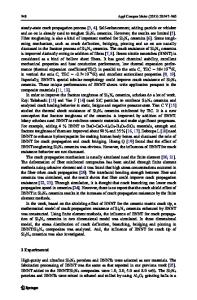Hardening Mechanisms of Amorphous / Polycrystalline Nanostructured Multilayer Films: Si 3 N 4 /CrN and Si 3 N 4 /TiN
- PDF / 944,058 Bytes
- 6 Pages / 595 x 842 pts (A4) Page_size
- 9 Downloads / 323 Views
Y5.7.1
Hardening Mechanisms of Amorphous / Polycrystalline Nanostructured Multilayer Films: Si3N4/CrN and Si3N4/TiN Junhua Xu, Lihua Yu, Yasushi Azuma, Koichiro Hattori, Toshiyuki Fujimoto, and Isao Kojima Materials Characterization Division, National Metrology Institute of Japan, National Institute of Advanced Industrial Science and Technology (AIST), AIST Tsukuba Central 5, Higashi 1-1, Tsukuba, Ibaraki 305-8565, Japan. ABSTRACT The amorphous/polycrystalline Si3N4/CrN and Si3N4/TiN nano-structured multilayer films have been fabricated by RF reactive magnetron sputtering. The microstructure and properties of these films were measured by XRD, HRTEM and nano-indenter. There is no superhardness effect in the Si3N4/CrN multilayers. The hardness values of Si3N4/CrN multilayers are between those of the constituent CrN and Si3N4 films at a substrate temperature of 20○C, and are a little higher than those of Si3N4 films at a deposition temperature of 500○C. However, the superhardness effect was found in Si3N4/ TiN multilayers. The hardness of Si3N4/ TiN multilayers is affected not only by modulation periods, but also by layer thickness ratio and deposition temperature. The maximum hardness value is about 40% higher than the value calculated from the rule of mixtures at a deposition temperature of 500○C and a layer thickness ratio (lSi3N4 / lTiN) of 3 / 1. Based on experimental results, the hardening mechanisms in these multilayers have been discussed. INTRODUCTION For amorphous/crystalline systems, Veprek et al [1] first reported that there are superhardness effects in a-Si3N4/ nc-TiN composite materials. The concept for the design of this superhard materials [2,3] is based on a combination of grain boundary hardening with decreasing crystalline size and blocking of grain boundary sliding by the formation of a strong interface between the two components. The maximum hardness more than 50.0 GPa is reached at such composite materials consisting of several nanometer crystalline embedded in very thin amorphous matrix. Are there superhardness effects in amorphous/crystalline multilayers? If there are, what are the hardening mechanisms? In this paper, the amorphous/polycrystalline Si3N4/CrN and Si3N4/TiN nano-structured multilayer films have been fabricated. We concentrate on the effect of deposition temperature, modulation period and layer thickness ratio on the hardness, in order to elucidate the hardening mechanisms in these multilayers. EXPERIMENTAL DETAILS CrN, TiN and Si3N4 single layer films and the CrN/Si3N4, TiN/ Si3N4 multilayer films with different modulation periods were prepared by a radio-frequency (r. f.) magnetron sputtering system. The sputtering targets were 3-in. single crystal silicon, pure metal Ti, and pure metal Cr. Boron-doped Si (100) wafers were used as substrates. High-purity argon and nitrogen gases were introduced into the chamber from mass flow controllers. The working pressure was 2.1 × 10-1 Pa with argon and nitrogen gas flows of 4 and 2 sccm. The target power was 100 W for Cr, 200 W for
Y5.7.2
Data Loading...











